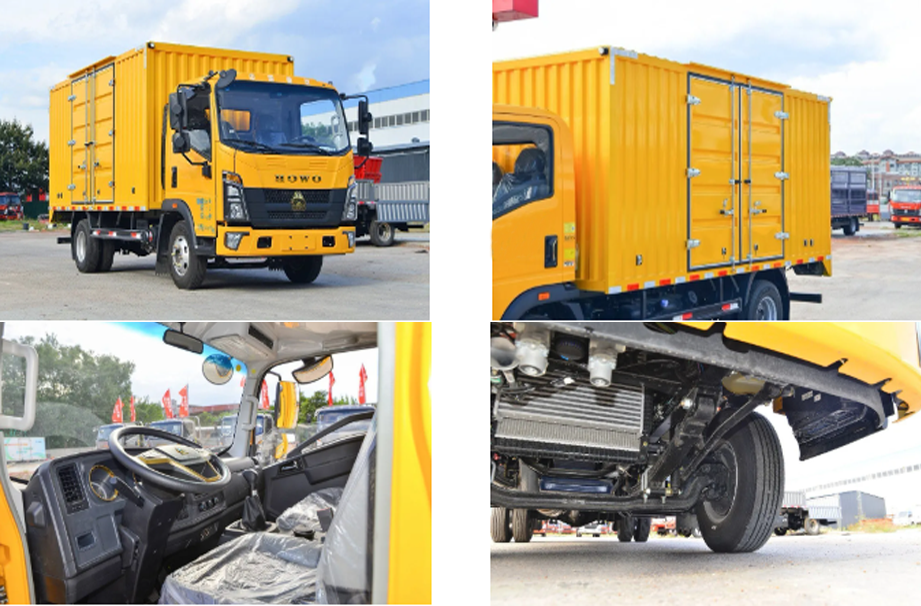Constructed with durable materials like steel or aluminum alloy, the cargo compartment is designed to withstand the rigors of daily use. It often comes with wide doors and a low loading floor, facilitating easy loading and unloading of items. Whether it's delivering parcels, transporting tools and equipment for service technicians, or hauling groceries for local stores, van trucks can handle diverse cargo needs.
Inside, there might be adjustable shelving and tie-down points to keep the load organized and secure. The driver's cabin is engineered for comfort, with ergonomic seating, intuitive controls, and good visibility. Equipped with reliable engines and sturdy suspensions, van trucks ensure a smooth ride, making them an efficient choice for urban deliveries and short-haul transportation, enhancing logistics operations.
| The Specification of 4X2 5Tons Van Truck | |
| Item No. | Parameters |
| Overall Dimension | 6995x2310x2570 mm |
| Gross Vehicle Weight | 7345kg |
| Curb Weight | 3550kg |
| Loading Weight | 4895Kg |
| Wheel Base | 3800mm |
| Front/rear Tread | 1120/2075 mm |
| Approach/Departure Angle | 21/20degree |
| Front Axle | 2850kg |
| Rear Axle | 4645kg |
| Gearbox | LC5T26, 5 speed, manual control |
| Engine | 4DX22-110, Diesel Engine, 4 in-line cylinder |
| Engine horsepower | 108HP EURO II |
| Displacement | 3.66 L (Diesel) |
| Full loading Fuel Consumption Rate | Maximum 215 g/kW.h |
| Max Driving Speed | 90 km/h |
| Cabin | 2 Passenger allowed |
| Tire | 8.25-16 LT (7 pieces) |
| Size: | 5100x2100x1400mm |
| Body Material | Strong Fiberglass Inner and Outer Wall, with 8cm Middle Polyfoam Insulation. |
| Refrigerator | High Quality Hanxue Refrigerator, Lowest Cooling Temperature negative 18 centi-degree (negative 608 Fahrenheit degree) |
| LOGO | Company Logo or any advertisement can be printed on the carriage body according to the customer's design. |

1. The chassis serves as the fundamental framework of the van truck. It's usually made of heavy-duty steel, engineered to bear the weight of both the cargo and the vehicle body. Reinforced cross-members are strategically placed to enhance rigidity and distribute the load evenly.
2. The van body is an enclosed, box-like structure, often fabricated from steel or aluminum alloy panels. Aluminum alloy is favored for its lightweight yet durable nature, contributing to better fuel efficiency and overall performance.
3. A well-designed suspension is vital for a smooth ride and cargo protection. Van trucks commonly employ a combination of leaf springs and shock absorbers or more advanced air suspension systems. Leaf springs are cost-effective and reliable, providing sturdy support for heavy loads.
4. The engine, typically a diesel or gasoline-powered unit, supplies the necessary power to propel the van truck. Diesel engines are renowned for their torque output, making them ideal for hauling heavy loads.
5. Inside the driver's cabin, ergonomic seats, a well-positioned steering wheel, and intuitive instrument panels enhance driver comfort and operation.
6. The electrical system powers essential components like lights, the ignition, and any onboard electronics. It includes a battery, alternator, and wiring harness.

1. Volume: Calculate the volume of cargo you typically need to transport. Van trucks come in different sizes, ranging from compact vans with a relatively small cargo area to large box trucks.
2. Payload Capacity: Determine the maximum weight of the cargo the van can carry. This depends on the strength of the chassis and suspension.
3. Delivery Range: Consider whether you'll be using the van for local, short-haul deliveries or long-distance transportation.
4. Type of Cargo: Different cargos have different requirements. If you're transporting perishable goods, you might need a van with temperature-control capabilities.
5. Power and Torque: The engine's power and torque are crucial, especially for vans that need to carry heavy loads or operate on hilly terrains. A diesel-powered engine generally provides more torque, which is beneficial for towing and hauling.
6. Fuel Efficiency: Fuel costs can be a significant part of operating expenses. Look for vans with good fuel-efficiency ratings.
7. Driver's Cabin: The driver's comfort is important, especially for long-haul trips. Look for a well-designed cabin with an ergonomic seat that provides good lumbar support.

Van trucks are renowned for their boxy, enclosed cargo compartments. Constructed from durable materials like steel or aluminum alloy, these compartments offer excellent protection to the transported goods.
Inside the cargo area, there are often multiple features for efficient load management. Adjustable shelving allows for customization based on the size and shape of the items being carried.
Compared to larger trucks, van trucks are relatively compact, which gives them excellent maneuverability.
The driver's cabin of a van truck is designed with operator comfort in mind. It typically features ergonomic seating to reduce fatigue during long hours of driving.
Van trucks are equipped with engines that are tailored to their specific needs. They can be diesel or gasoline-powered, with diesel engines being popular for their high torque output, which is beneficial for hauling heavy loads.
These vehicles offer a high degree of customizability. Businesses can outfit the van trucks according to their unique requirements.

